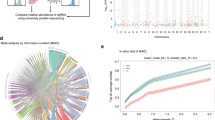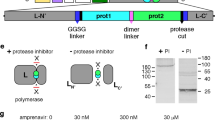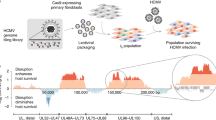Abstract
We describe a transcription-based assay system to screen for antiviral drugs in vivo. The system consists of two transcription units, a cytomegalovirus promoter driving a reporter gene physically linked to an HIV-1 promoter oriented in the opposite direction. Based on the arrangement of the transcription units, enhanced HIV-1 promoter activity in the presence of the viral transactivating Tat protein downregulates reporter gene expression initiated from the CMV promoter. Inhibitors of HIV-1 transcription relieve the suppression and are identified by an increase in reporter gene expression. This positive selection system allows discrimination between drugs that nonspecifically block cellular functions by cytotoxicity and molecules that specifically repress HIV-1 promoter activity.
This is a preview of subscription content, access via your institution
Access options
Subscribe to this journal
Receive 12 print issues and online access
$209.00 per year
only $17.42 per issue
Buy this article
- Purchase on Springer Link
- Instant access to full article PDF
Prices may be subject to local taxes which are calculated during checkout
Similar content being viewed by others
References
Cullen, B.R. and Greene, W.C. 1989. Regulatory pathways governing HIV-1 replication. Cell 58: 423–426.
Gaynor, R. 1992. Cellular transcription factors involved in the regulation of HIV-1 gene expression. AIDS 6: 347–363.
Roulston, A., Lin, R., Beauparlant, P., Wainberg, M.A., and Hiscott, J. 1995. Regulation of human immunodeficiency virus type 1 and cytokine gene expression in myoloid cells by NF-kB/Rel transcription factors. Microbiol. Rev. 59: 481–505.
Selby, M.J., Bain, E.S., Luciw, P.A., and Peterlin, B.M. 1989. Structure, sequence, and position of the stem-loop in tar determine transcriptional elongation by tat through the HIV-1 long terminal repeat. Genes Dev. 3: 547–558.
Sharp, P.A. and Marciniak, R.A. 1989. HIV TAR: an RNA enhancer? Cell 59: 229–230.
Marciniak, R.A., Garcia-Blanco, M.A., and Sharp, P.A. 1990. Identification and characterization of a HeLa nuclear protein that specifically binds to the trans-activation-responsive TAT element RNA. Proc. Natl. Acad. Sci. USA 87: 3624–3628.
Wu, F., Garcia, J., Sigman, D., and Gaynor, R. 1991. Tat regulates binding of the human immunodeficiency virus trans-activating region RNA loop-binding TRP-185. Genes Dev. 5: 2128–2140.
Sheline, C., Milocco, L.H., and Jones, K. 1991. Two distinct nuclear transcription factors recognize loop and bulge residues of the HIV-1 TAR RNA hairpin. Genes Dev. 5: 2508–2520.
Mhashilkar, A.M., Bagley, J., Chen, S.Y., Szilvay, A.M., Helland, D.G., and Marasco, W.A. 1995. Inhibition of HIV-1 Tat-mediated LTR transactivation and HIV-1 infection by anti-Tat single chain intrabodies. EMBO J. 14: 1542–1551.
Rice, W.G., Supko, J.G., Malspeis, L., Buckheit, R.W. Jr., Clanton, D., Bu, M., et al. 1995. Inhibitors of HIV nucleocapsid protein zinc fingers as candidates for the treatment of AIDS. Science 270: 1194–1197.
Hsu, M.-C., Schutt, A.D., Holy, M., Slice, L.W., Sherman, M.I., Richman, D.D., et al. 1991. Inhibition of HIV replication in acute and chronic infections in vitro by a Tat antagonist. Science 254: 1799–1802.
Hsu, M.-C., Dhingra, U., Earley, J.V., Holly, M., Keith, D., Nalin, C.M., et al. 1993. Inhibition of type 1 human immunodeficiency virus replication by a Tat antagonist to which the virus remains sensitive after prolonged exposure in vitro. Proc. Natl. Acad. Sci. USA 90: 6395–6399.
Sarver, N., Black, R.J., Bridges, S., and Chrisey, L. 1992. Frontiers in HIV-1 therapy: Fourth conference of the NIAID national cooperative drug discovery groups-HIV. AIDS Res. Hum. Retroviruses 8: 659–666.
Witvrouw, W., Pauwels, R., Vandamme, A.-M., Schols, D., Reymen, D., Yamamoto, N., et al. 1992. Cell type-specific anti-human immunodeficiency virus type I activity of the transactivation inhibitor Ro5-3335. Antimicrob, Agents Chemothr. 36: 2628–2633.
Feinberg, M.B., Baltimore, D., and Frankel, A.D. 1991. The role of Tat in the human immunodeficiency virus life cycle indicates a primary effect on transcriptional elongation. Proc. Natl. Acad. Sci. USA 88: 4045–4049.
Cullen, B.R. 1993. Does HIV-1 Tat induce a change in viral initiation rights? Cell 73: 417–420.
Kao, S.-Y., Calman, A.F., Luciw, P.A., and Peterlin, B.M. 1987. Antitermination of transcription within the long terminal repeat of HIV-1 by tat gene product. Nature 330: 489–493.
Greenblatt, J., Nodwell, J.R., and Mason, S.W. 1993. Transcriptional antltermination. Nature 364: 401–406.
Zenzie-Gregory, B., Sheridan, P., Jones, K.A., and Smale, S.T. 1993. HIV-1 core promoter lacks a simple Initiator element but contains bipartite activator at the transcription start site. J. Biol. Chem. 268: 15823–15832.
Rittner, K., Churcher, M.J., Gait, M.J., and Karn, J. 1995. The human immunodeficiency virus long terminal repeat includes a specialised initiator element which is required for Tat-responsive transcription. J. Mol. Biol. 562: 562–580.
Izant, J.G. and Weintraub, H. 1994. Inhibition of thymldine kinase gene expression by antisense RNA: a molecular approach to genetic analysis. Cell 36: 1007–1015.
Wagner, R.W. 1994. Gene inhibition using antisense oligodeoxynucleotides. Nature 372: 333–335.
Sullenger, B.A., Gallardo, H.F., Ungers, G.E., and Gilboa, E. 1990. Overexpression of TAR sequences renders cells resistant to human immunodeficiency virus replication. Cell 63: 601–608.
Graham, G.J. and Maio, J.J. 1991. RNA transcripts of the human immunodeficiency virus transactivation response element can inhibit action of the viral trans-activator. Proc. Natl. Acad. Sci. USA 87: 5817–5821.
Jones, K.A. and Peterlin, B.M. 1994. Control of RNA initiation and elongation at the HIV-1 promoter. Annu. Rev. Biochem. 63: 717–743.
Wang, J.C. 1991. DNA topoisomerases: why so many? J. Biol. Chem. 266: 6659–6662.
Matthias, P., Mueller, M., Schreiber, E., Rusconi, S., and Schaffner, W. 1989. Eukaryotic expression vectors for the analysis of mutant proteins. Nucleic Acids Res. 17: 6418–6418.
Sanchez-Pescador, R., Power, M.D., Barry, P.J., Stimer, K.S., Stempien, M.M., Brown-Shimer, S.L., et al. 1985. Nucleotide sequence and expression of an AIDS-associated retrovirus (ARV-2). Science 227: 484–492.
Ogawa, E., Maruyama, M., Kagoshima, H., Inuzuka, M., Lu, J., Satake, M., et al. 1993. PEBP2α/PEA2 represents a family of transcription factors homologous to the products of the Drosophila runt gene and the human AML1 gene. Proc. Natl. Acad. Sci. USA 90: 6859–6863.
Takebe, Y., Seiki, M., Fijisawa, J., Hoy, P., Yokota, K., Arai, K., et al. 1988. SR alpha promoter: an efficient and versatile mammalian cDNA expression system composed of the simian virus 40 early promoter and the R-U5 segment of human T-cell leukemia virus type 1 long terminal repeat. Mol. Cell. Biol. 8: 466–472.
Zhang, Y., Proenca, R., Maffei, M., Barone, M., Leopold, L., and Friedman, J.M. 1994. Positional cloning of the mouse obese gene and its human homologue. Nature 372: 425–432.
Giese, K. and Grosschedl, R. 1993. LEF-1 contains an activation domain that stimulates transcription only in a specific context of factor-binding sites. EMBO J. 12: 4667–4676.
Author information
Authors and Affiliations
Rights and permissions
About this article
Cite this article
Rosario, M., Stephans, J., Zakel, J. et al. Positive selection system to screen for inhibitors of human immunodeficiency virus-1 transcription. Nat Biotechnol 14, 1592–1596 (1996). https://doi.org/10.1038/nbt1196-1592
Received:
Accepted:
Issue Date:
DOI: https://doi.org/10.1038/nbt1196-1592
This article is cited by
-
An antisense-based functional genomics approach for identification of genes critical for growth of Candida albicans
Nature Biotechnology (2001)
-
Taking out Tat
Nature Biotechnology (1996)



